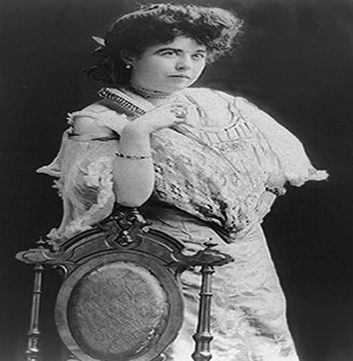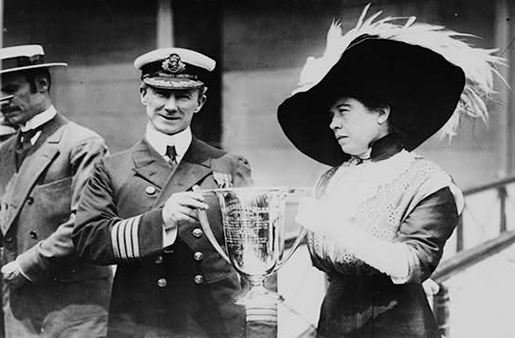Margaret “Molly” Brown - Titanic First Class Passenger
Mrs Margaret Brown, now also widely known as Molly Brown, was a 44 year old first class passenger traveling home from Europe. Today she is one of the most well-known of Titanic’s passengers. Travelling home from Europe, Margaret Brown boarded Titanic during the evening of 10th April 1912, at Cherbourg, France. In a hurry to return home due to hearing her grandson was unwell, she was travelling home alone, although did have friends aboard Titanic.

Margaret Brown
She was born on 18th July 1867 in Hannibal, Missouri, United States. Her parents were John and Johanna Tobin, both born in Ireland. Her family, although seemingly living comfortably in a decent, though maybe crowded, house, were a working class family and at the time of her birth her family certainly would not have been travelling the Atlantic in first class. After finishing her education at around 13 years old, Margaret started working as a labourer for a tobacco company .
In 1883 Jack Landrigan and his newlywed wife, Mary Anne, who was Margaret sister moved to Leadville, Colorado, where Jack set up a blacksmith’s shop; in 1885 Margret Brown’s brother, Daniel, permanently made the move to the same place. In 1886 Daniel paid for his sister, Margret, aged 18, to join him in Leadville. In Leadville, Margaret lived in a rented house with her brother. Her brother was working as a miner, and she found a job in the carpet and drapery department at Daniels, Fisher, & Smith, sewing.
Not long after moving to Leadville, at a church picnic, Margaret met James Joseph Brown (born in 1854), a talented and experienced miner. They were married on 1st September 1886 at Annunciation Church, Leadville. They soon moved into initially a miner’s cabin, and then into a house once they had their first child. They had two children, Lawrence Palmer Brown, born on 30th August 1887, and Catherine Ellen Brown, born on 1st July 1889.
It is said that Margaret was involved with charity work, including soup kitchens, helping miners and their families who were in need of help.
In 1893, due to the price of silver falling, the area in which Margaret lived, an area with many employed in silver mining, was thrown into depression, with high unemployment. At this time Margaret’s husband, James Joseph Brown, working for the Ibex mining company, devised and implemented a plan to mine gold, instead of silver, from the Little Johnny mine, using hay bales and timber as support; a huge amount of gold was discovered and mined; making an absolute fortune. James Joseph Brown was well rewarded with vast shares in the company and a place on its board of directors. Margaret Brown could now afford to travel the Atlantic first class.
Now wealthy, they moved to and bought a large home in Denver. Living with them were Margaret’s parents; it is said that she had always wanted to provide comfort for her parents. In Denver, Margaret became an original member of the Denver Woman's Club – an organisation that had political and social interests. She also made a successful effort to better educate herself.
Margaret Brown become involved with fundraising for Ben Lindsey, a judge and social reformer, efforts concerning children, including helping children in need, and adequately provide for children who found themselves in the justice system.
Unfortunately Margaret did not remain happily married. The couple never did divorce – but in August 1909 they did sign a separation agreement.
Before women even had the right to vote to vote in the United States, Margaret, it is said, twice ran for the US senate.
On 24th January 1912, Margaret set sail for Europe aboard RMS Olympic; unplanned, a little under 3 months later, she would be returning home aboard the maiden voyage of Olympic’s sister ship, Titanic. She was sailing to meet her daughter in France, from where they toured Europe and Egypt. Also sailing aboard Olympic during that voyage were others who would also be aboard Titanic including J Bruce Ismay, John Jacob Astor and his wife Madeline Astor. Margaret and her daughter spent time with the Astor’s during their tour, including visiting the Sphinx in Egypt.
In France, Margaret received a message that her young grandson, Lawrence Palmer Brown, Jr (born 21st November 1911) was unwell; so she decided to book passage home aboard the Titanic. Booking her ticket the day before Titanic set sail, she was amongst the last people to book to sail aboard Titanic.
With her daughter staying behind, Margaret boarded Titanic on 10th April 1912, when Titanic called at Cherbourg, France. Making the journey home with her were three crates containing models of the ruins of Rome, which were intended for the Denver Art Museum. Also with her was a small Egyptian talisman that she had bought in Egypt, and is said she had been carrying with her for good luck.
Late during the evening of 14th April 1912, at 11.40pm, Margaret was in her cabin reading at the time Titanic collided with the iceberg. After the order was given to load the lifeboats, Margaret found herself in Lifeboat 6, one of the first lifeboats to leave the port side of Titanic during the sinking. It is said that Margaret was not intending to enter lifeboat 6, having other ideas, it is said she was placed in the lifeboat by a crewman at the last moment. In her possession as she was lowered away from Titanic was the small Egyptian talisman that she had bought.
In the lifeboat, Margaret Brown and the other women in the boat helped with the rowing. In Colonel Gracie’s 1912 book about the disaster, an account provided by Margaret describes how she had threatened to throw Quartermaster Robert Hichens , who was in charge of the lifeboat, overboard after he disagreed with her.
Margaret and the other survivors of the disaster were rescued by the Cunard Line ship RMS Carpathia. Aboard Carpathia, Margaret did what she could to help the other survivors. She also with a group of survivors set up the Titanic Survivors Committee.
On 29th May 1912, when Carpathia returned to New York for the first time since she arrived there with Titanic’s survivors, the Titanic Survivors Committee, including Margaret, presented Carpathia’s captain, Arthur Rostron, with a ‘silver loving cup’ and a medal for Captain Rostron and every member of the crew who were aboard Carpathia when they raced to Titanic’s rescue. The small Egyptian talisman that had been rescued with Margaret, she gave to Captain Rostron as a thank you.

Margaret Brown with Arthur Rostron and the ‘silver loving cup’.
In the years after Titanic, Margaret was notable for her political and social interests.
After the First World War had ended Margaret was involved with the American Committee for Devastated France; set up to help France recover from the war. For her work, she was awarded the French Legion of Honor in 1932.
Margaret Brown died suddenly, aged 65, on 26th October 1932, while at the Barbizon Hotel , New York. Her death was caused by a brain tumour. She was buried with her husband, James Joseph Brown, at Cemetery of the Holy Rood, Westbury New York. James Joseph Brown had died on 5th September 1922.
On 3rd November 1960, the musical The Unsinkable Molly Brown opened at the Winter Garden Theatre, New York. With the book written by Richard Morris and the music and lyrics by Meredith Willson, the musical, mostly a work of fiction, tells the story of Margaret Brown’s life. Released on 11th June 1964, The Unsinkable Molly Brown was turned into a film starring Debbie Reynolds as Molly Brown.
Today Margaret Brown, now one of the most known about people to have been aboard Titanic, is widely known by the name Molly Brown; in fact, she was never actually known as Molly during her lifetime. The name Molly was likely first popularised by the Unsinkable Molly Brown musical and film. It is said that Molly is easier to sing than Margaret.
The character Margaret Brown is often a prominent character in Titanic productions such as in the 1958 Titanic film A night to Remember played by Tucker McGuire; the 1979 television movie S.O.S. Titanic played by Cloris Leachman; the 1996 'mini series' Titanic played by Marilu Henner; and the 1997 Titanic film played by Kathy Bates.
Related pages - Titanic's First Class Passengers, All Titanic Pages